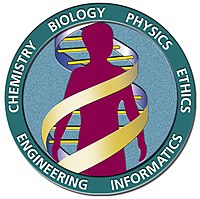
Photo from wikipedia
Cells and cell lines are used for multiple applications such as bioprocessing, therapy, and research. To ensure quality of cells and downstream applications, appropriate quality control (QC) methods are critical.… Click to show full abstract
Cells and cell lines are used for multiple applications such as bioprocessing, therapy, and research. To ensure quality of cells and downstream applications, appropriate quality control (QC) methods are critical. Historically, karyotyping has been employed, but it is limited by its very low resolution and tedious laboratory workflow. Other methods such as PCR and targeted sequencing can characterize only small genomic variants at specific loci. Whole genome sequencing can detect small variants genome-wide but has limited sensitivity in detecting structural variants (SVs). Optical genome mapping (OGM) is a novel genome analysis technique that can fill many of the gaps in current capabilities for assessing genome integrity. To find clonal variants, 400 Gbp of data is collected from the parental/control and test samples. For both samples, a de novo assembly is constructed, and homozygous or heterozygous SVs are assessed. Subsequently, Bionano Access software’s dual variant annotation pipeline identifies unique SVs in the test sample compared to the parental sample. To discover subclonal SVs down to 5% variant allele fraction (VAF), the workflow leverages the generation of 1.5 Tbp of data, requiring a simple adjustment to longer data collection time. Comparison of test sample to parental sample easily enables the determination of acquired variants. Finally, generation of ~5 Tbp of data, requiring 2-3 flow cells to be run, enables the detection of SVs at ultra-low VAF down to ~1%. In this study, several dilutions and simulations were performed to examine OGM’s limit of detection. Targeting a coverage of 5 Tbp and analysis using the somatic SV-analysis workflow revealed that OGM has the sensitivity to detect deletions >50kbp, insertions >20kbp, duplications >100 kbp, and translocations at ~1% VAF. We have applied the clonal and somatic workflows to verify genomes’ integrity after cell immortalization, induced pluripotency, transgene-integration, and gene-editing. The data using the robust and sensitive workflows demonstrate that the OGM platform is a cost-effective solution for cell manufacturing/bioprocessing QC applications. Citation Format: Alex R. Hastie. Genome Integrity assessment and verification by optical genome mapping for cell manufacturing/bioprocessing applications [abstract]. In: Proceedings of the American Association for Cancer Research Annual Meeting 2023; Part 1 (Regular and Invited Abstracts); 2023 Apr 14-19; Orlando, FL. Philadelphia (PA): AACR; Cancer Res 2023;83(7_Suppl):Abstract nr 2074.
Journal Title: Cancer Research
Year Published: 2023
Link to full text (if available)
Share on Social Media: Sign Up to like & get
recommendations!